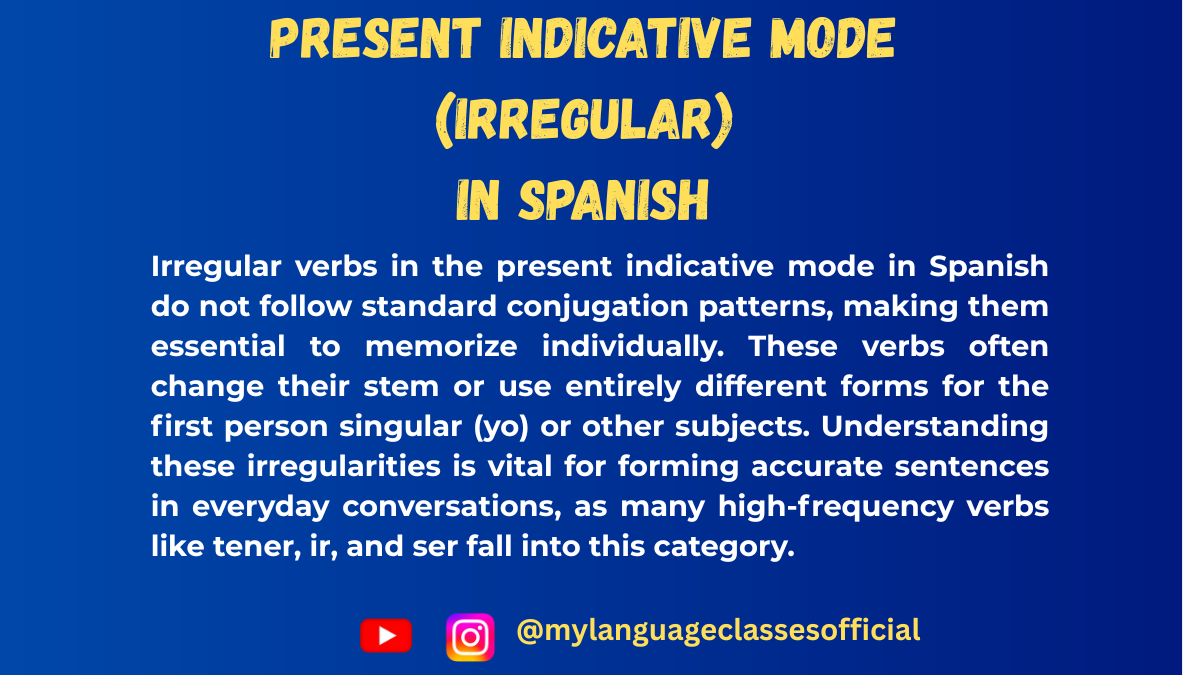Your cart is currently empty!
Irregular Verbs in the Present Indicative Mode in Spanish

Mastering Irregular Verbs in the Present Indicative mode in Spanish
Learning Spanish can be an exciting adventure, but the irregular verbs in the present indicative mode can often make it feel like a tricky puzzle. Don’t worry! In this blog post, we’ll break down the categories of irregular verbs and provide clear examples to help you navigate through them. Whether you’re a beginner or looking to solidify your skills, this guide is for you.
What is the Present Indicative Mode?
The present indicative mode is used to describe actions happening right now, habitual actions, or general truths. While most verbs follow a regular conjugation pattern, some verbs have irregularities. These irregular verbs fall into distinct categories that can be easily learned with practice.
1. Stem-Changing Verbs (Boot Verbs)
Stem-changing verbs undergo a vowel change in the stem in all forms except nosotros and vosotros. The three main changes are:
- e → ie
- o → ue
- e → i
e → ie Verbs
These verbs replace the vowel e with ie in all forms except nosotros and vosotros.
| Infinitive | Yo | Tú | Él/Ella/Usted | Nosotros | Vosotros | Ellos/Ellas/Ustedes |
|---|---|---|---|---|---|---|
| Pensar | Pienso | Piensas | Piensa | Pensamos | Pensáis | Piensan |
| Querer | Quiero | Quieres | Quiere | Queremos | Queréis | Quieren |
Other e → ie Verbs:
Preferir, cerrar, comenzar, entender.
o → ue Verbs
These verbs replace the vowel o with ue in all forms except nosotros and vosotros.
| Infinitive | Yo | Tú | Él/Ella/Usted | Nosotros | Vosotros | Ellos/Ellas/Ustedes |
|---|---|---|---|---|---|---|
| Dormir | Duermo | Duermes | Duerme | Dormimos | Dormís | Duermen |
| Volver | Vuelvo | Vuelves | Vuelve | Volvemos | Volvéis | Vuelven |
Other o → ue Verbs:
Morir, almorzar, costar, encontrar.
e → i Verbs
These verbs replace the vowel e with i in all forms except nosotros and vosotros.
| Infinitive | Yo | Tú | Él/Ella/Usted | Nosotros | Vosotros | Ellos/Ellas/Ustedes |
|---|---|---|---|---|---|---|
| Pedir | Pido | Pides | Pide | Pedimos | Pedís | Piden |
| Servir | Sirvo | Sirves | Sirve | Servimos | Servís | Sirven |
Other e → i Verbs:
Repetir, elegir, vestir.
2. Yo Irregulars
In these verbs, the irregularity occurs only in the yo form, with specific spelling changes:
- Verbs ending in -cer or -cir change to -zco in the yo form.
- Verbs ending in -ger or -gir change to -jo in the yo form.
-cer / -cir → -zco
| Infinitive | Yo | Tú | Él/Ella/Usted | Nosotros | Vosotros | Ellos/Ellas/Ustedes |
|---|---|---|---|---|---|---|
| Conocer | Conozco | Conoces | Conoce | Conocemos | Conocéis | Conocen |
| Traducir | Traduzco | Traduces | Traduce | Traducimos | Traducís | Traducen |
Other -cer/-cir Verbs:
Ofrecer, producir, parecer.
-ger / -gir → -jo
| Infinitive | Yo | Tú | Él/Ella/Usted | Nosotros | Vosotros | Ellos/Ellas/Ustedes |
|---|---|---|---|---|---|---|
| Escoger | Escojo | Escoges | Escoge | Escogemos | Escogéis | Escogen |
| Dirigir | Dirijo | Diriges | Dirige | Dirigimos | Dirigís | Dirigen |
Other -ger/-gir Verbs:
Exigir, proteger.
3. Totally Irregular Verbs
These verbs do not follow any predictable patterns and must be memorized individually.
Ser (to be)
| Yo | Tú | Él/Ella/Usted | Nosotros | Vosotros | Ellos/Ellas/Ustedes |
|---|---|---|---|---|---|
| Soy | Eres | Es | Somos | Sois | Son |
Ir (to go)
| Yo | Tú | Él/Ella/Usted | Nosotros | Vosotros | Ellos/Ellas/Ustedes |
|---|---|---|---|---|---|
| Voy | Vas | Va | Vamos | Vais | Van |
Other Totally Irregular Verbs:
Haber, estar.
4. Spelling Changes for Phonetic Reasons
Verbs ending in -uir (except -guir) add a y in all forms except nosotros and vosotros.
| Infinitive | Yo | Tú | Él/Ella/Usted | Nosotros | Vosotros | Ellos/Ellas/Ustedes |
|---|---|---|---|---|---|---|
| Construir | Construyo | Construyes | Construye | Construimos | Construís | Construyen |
Other Verbs with Spelling Changes:
Incluir, destruir, huir.
Wrapping Up
By categorizing irregular verbs and practicing with these tables, you can systematically conquer their complexities. The key is consistency and practice. Bookmark this guide and refer back to it as you progress on your Spanish journey.
¿Cuáles son tus verbos irregulares favoritos? Share your thoughts in the comments below!
If you found this guide helpful, I’d love to hear from you! Share your thoughts in the comments below or connect with me on social media. For more tips, resources, and inspiration, visit my blog at mylanguageclasses.in. Follow on Instagram and subscribe on YouTube
Vikas Kumar is a dedicated language educator, content creator, and digital entrepreneur, best known as the co-founder of My Language Classes and The Curious Mind. With a strong focus on helping learners achieve fluency in English, Spanish, and Japanese, he has guided audiences worldwide through a diverse range of resources, including in-depth blog articles, engaging YouTube tutorials, and comprehensive Books.
Through My Language Classes, Vikas has built a thriving multilingual learning platform that serves students, travelers, and professionals eager to master communication skills for personal, academic, and professional success. His expertise extends to exam preparation for internationally recognized certifications such as JLPT, DELE, IELTS, and TOEFL, enabling learners to achieve tangible, career-enhancing results.
As the founder of The Curious Mind, he also explores broader areas of knowledge, including self-help, motivation, modern learning strategies, and thought-provoking insights on life and personal growth. His work blends practical teaching methods with a deep understanding of learner psychology, making complex concepts accessible and engaging.
Driven by a mission to make high-quality education accessible to all, Vikas continues to expand his reach across multiple platforms, including YouTube, blogs, eBooks, and social media communities, inspiring thousands to learn, grow, and embrace lifelong learning.


Leave a Reply